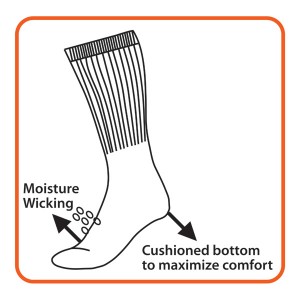The Importance of Choosing the Right Socks
Sports, hiking and outdoor activities can be tough on your feet; a good pair of high-tech sport socks is your first line of protection for dry, comfortable, and blister-free feet. Runners, hikers, soldiers, and participants in any type of sports activity should choose their socks cautiously to prevent blisters and other foot problems. The NFL and NBA Have made acrylic socks part of their official uniforms. Elite athletes of all types are using acrylic socks because of their elasticity, shape retention, and moisture control. Our feet have 250,000 sweat glands causing the average male foot to produce up to a cup of sweat a day! That is 10 to 15 gallons of sweat a year. Sweat is the perfect environment for bacteria to grow in, and bacteria lead to blisters. That is why we believe the most important attribute of an athletic sock is its ability to transfer sweat away from the foot.Acrylic Fabric
Acrylic is a lightweight man-made synthetic fiber known for its softness and high durability. It provides good cushioning and excellent friction and moisture management. Acrylic does not absorb high amounts of moisture, but instead works to wick it away, in other words transport moisture away from the foot.Studies and facts
Many studies on acrylic versus cotton socks have been conducted. One study and its findings, conducted by Dr Douglas H Ritchie Jr., can be found on the American Academy of Podiatric Sports Medicine website at: www.aapsm.org/socknov97.html Findings:- Cotton fiber retains 3 times the moisture of acrylic
- When exposed to ambient air – cotton retains moisture 10 times longer than acrylic
- When wet – acrylic fibers swell less than 5%, while cotton swells 45% and wool 35%
- Acrylic tends to dry faster than cotton
- Cotton socks produce twice as many blisters as acrylic socks, and the blisters produced by cotton socks are 3 times as big as blisters produced by acrylic
- Athletes were able to observe a drier foot with acrylic socks compared with cotton socks
- Cotton socks exhibit a 2.4 times higher resistance to moisture transport than acrylic

 Call Now: 858-404-0144 email: info@dryons.com
Call Now: 858-404-0144 email: info@dryons.com
